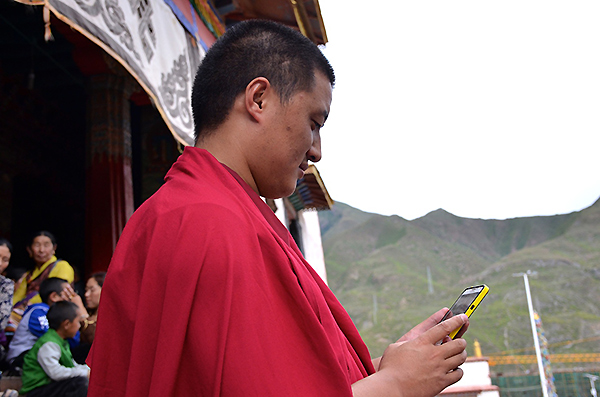 |
|
Champa Kalzang checks his smartphone at the Champa Ling Monastery in Qamdo, a city in the east of the Tibet autonomous region, Aug 7, 2015. [Photo by Chen Bei/chinadaily.com.cn] |
Tibet has a high rate of cellphone penetration and Internet usage. About 95 percent of the regional population is registered as cellphone users and by the end of July about 70 percent used the Internet regularly, according to the latest data from the regional Development and Reform Commission.
The majority of Tibetans use smartphones, as indicated by a 2014 consumer-spending report by Alipay, the payment arm of e-commerce giant Alibaba Group Holdings, which showed that Tibetans accounted for the highest number of mobile payments – 62.2 percent – in the first 10 months of last year.
The Champa Ling Monastery is home to about 1,200 monks, and more than 700 of them own tablet computers and smartphones, including top brands such as Samsung, Huawei and Apple, according to Champa Kalzang, a 26-year-old monk.
Champa also uses WeChat, sharing his "moments" with friends. "I don't think mobile gadgets will distract me from Buddhist practises," he said, adding that he likes to "take things as they come".
"Social networking helps me keep up with the times, and I can also use it to promote Tibetan Buddhist culture because photos about rituals, religious stories and art are always given more 'likes'," he said. Champa downloads Buddhist scriptures onto his 11-centimeter-screen phone, which helps him to recite the sutras outside study periods.
The widespread use of electronic devices at the Champa Ling Monastery is not uncommon, according to Tenzin. "Most monks in Tibet's monasteries who were born after 1980 use mobile devices, although the senior are slow to adapt to such gadgets, "he said.
Located more than 1,200 km west of Qamdo, the Tashihunpo Monastery has adopted highly advanced technology to benefit visitors and pilgrims.
Since the beginning of this year, the traditional seat of the Panchen Lama in Xigaze, Tibet's second-largest city, has used a quick-response code system, under which the code is posted in front of every assembly hall.
Visitors can scan the QR code and select audio in three languages, Tibetan, Mandarin and English, and hear about the monasteries history on their cellphones.
"We invited some experts, including faculty members from Tibet University, to improve the quality of the translations," said Kachen Buchung, a leading monk, who added that the system has proved a hit among visitors.
"When tour guides are in short supply, the audio instruction system is an alternative, free measure to fulfill visitors' needs," he said.
About 70 percent of the monastery's monks have smartphones and 20 percent own laptops, according to Kachen, who said many of them use electronic devices to read scriptures and learn Mandarin and even English.
"Many translation apps are fantastic. When we input something in Tibetan, the Mandarin translation just pops right out," he said.
Contact the writers at: chenbei@chinadaily.com.cn and luowangshu@chinadaily.com.cn